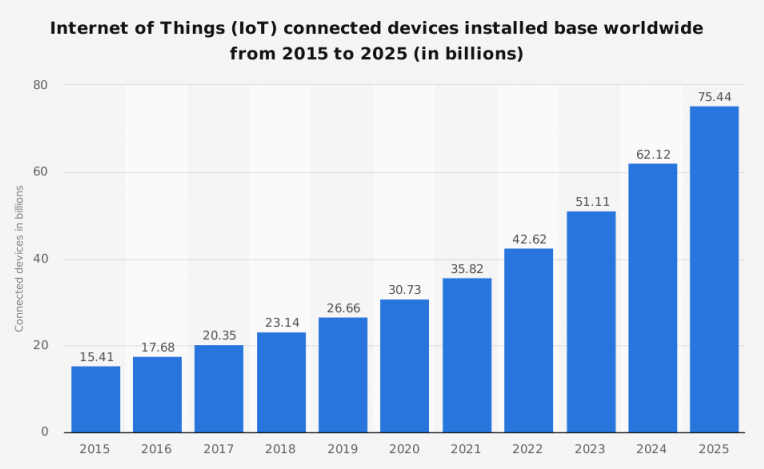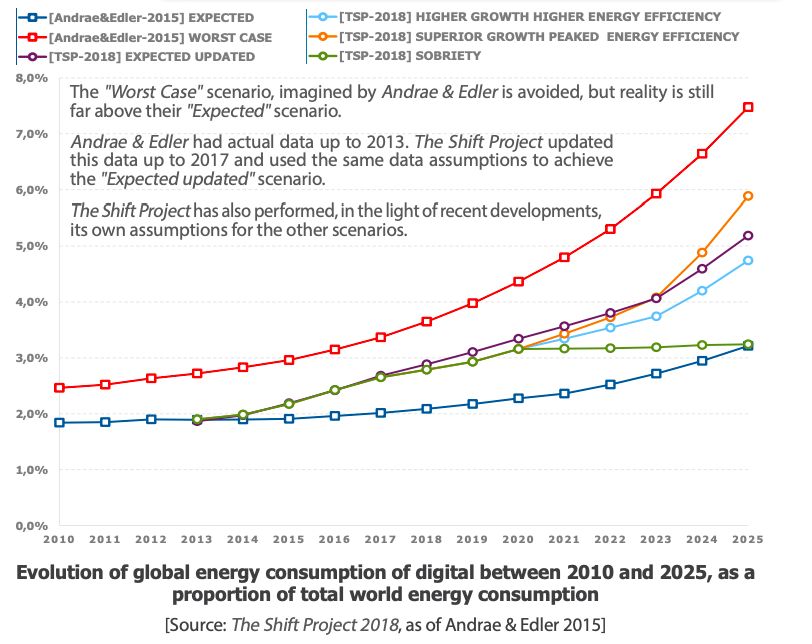The French Agency for Ecological Transition (ADEME) tells us that ecodesign emerged at the international level in 2002 when a wonderful standard with the sweet name of ISO/TR 14062 was published. The objective of this standard was to integrate environmental aspects into the design and development of products.
Here we are, the foundations were laid!
But let’s give some historical context before talking about ecodesign: in 2002, the dot-com bubble was just behind us, and Amazon was finally becoming profitable for the first time in its short history, by exceeding $1 billion in sales on its global e-commerce platform.
Today, 20 years later, Amazon’s turnover is more than 110 billion dollars and the huge profits are no longer only linked to this e-commerce platform but to its Cloud, AWS, which accounts for more than half of this figure.
Of course, the other cloud players such as Microsoft Azure, Google Cloud Platform, or IBM Cloud, are not left behind, with Chinese clouds such as Alibaba, Baidu or Tencent soaring.
Gartner estimates that by 2022, the public Cloud will be worth $400 billion, and if we take into account the entire Cloud, we’ll reach $1 trillion.

If all these figures were still necessary to understand the magnitude of the Web in 20 years, both in our personal and professional lives, it would not be enough to describe the global digital consumption frenzy.
This frenzy is not only that of the world, of others, it is also ours: you and I, while we had a computer 20 years ago, we now have one or more laptops, tablets, cell phones, and sometimes all kinds of connected objects such as a TV, a doorbell, an electrical outlet, light bulbs or a baby phone.

With Covid-19, teleworking has become more and more important in our lives, and we sometimes had to acquire a printer or a second screen, to avoid losing our eyes in addition to our social life.
The Digital Market Barometer published on the website of the French Ministry of the Economy and Finance tells us that :
● In France alone, more than 8 out of 10 people (84%) have a smartphone: that’s +7% in one year
● More than one in two people have a tablet (56%): that’s +14% in one year
● Multi-equipment with Internet access devices concerns 73% of French people (+5% for 3 devices)
Digital technology has become essential to us: as individuals, with the purchase and consumption of digital equipment, but also for our companies, which have begun their digital transformation as part of the race for competitiveness.
Digital Technology accounts for 4% of greenhouse gas emissions
This consumption of devices and this use of digital technology have a particularly obvious impact on our planet, on its resources, and more precisely on the carbon footprint and the concentration of greenhouse gases.
Today, digital technology represents:
● 4% of greenhouse gas emissions worldwide. In comparison, this is twice as much as air transport. And this figure will probably double by 2025!
● 10% of global electricity consumption

Initially, we thought that digitalization would make us greener and that if we read the press digitally, it would avoid cutting down trees. But it is not that simple, and it is urgent that homo digitalis realizes its consumption and its unconsidered and uncontrolled environmental impact.
I would like to remind you very quickly that the greenhouse effect is a natural phenomenon that has always protected us by guaranteeing viable temperatures on Earth. However, by strongly increasing them, human activity is disrupting the climate and the catastrophic effects are likely to accelerate, knocking at our door to open our eyes, if we still look away.
And if you think that climate disruption is just going to allow us to take off our sweaters and stay in t-shirts sipping cocktails, I invite you to watch this short video:
We now know that many factors contribute to increasing greenhouse gases, but let’s focus on the factors related to digital technology.
To understand the impact of digital technology on the environment, we have to remember that there are 3 main sources of digital pollution according to the French Agency for Ecological Transition:
1. Digital Devices
From their manufacturing chain, which consumes a large amount of fossil energy, to their assembly, which takes place on the other side of the world, and during their transportation to the point of sale: the carbon impact of digital devices is tremendous. Digital equipment alone accounts for 47% of greenhouse gases.
2. The Internet
The network required for an Internet connection is made up of multiple cabled networks, and a large part of them are underwater, covering hundreds or even thousands of kilometers of the sea bed. The installation of these cables, as well as the maintenance of the networks, consumes a significant amount of energy. Network infrastructures account for 28% of greenhouse gas emissions from digital consumption.
3. Data Centers
All the personal and professional data we store goes through data centers: our documents, our emails, our photos, and our videos. And they need a lot of electricity to run hundreds of servers and the air conditioning that it requires. Most of this electricity is produced by coal-fired power plants (if we exclude France, whose electricity comes mainly from nuclear power). Data centers account for 25% of greenhouse gas emissions from the digital sector.
With these figures in front of us, we all need to act, and the eco-responsibility of all of us in the digital industry starts with the convergence of digital transformation and ecological transition.
Taking action means making responsible digital technology part of our daily professional life
I won’t go into an explanation of the carbon footprint, or of the GHG assessments that companies must carry out, but to identify the levers for action, you will have to measure your carbon footprint.
However, you can and must already guide your digital projects towards digital sobriety: this does not mean doing less, but doing as much or better, with less.
Integrate ecodesign systematically in your projects to get closer to digital sobriety
In practical terms, to reduce your environmental footprint for the creation of a website and/or a mobile application, you must target actions on the following levers:
● The devices themselves: the computers of your users, the smartphones of your mobile users
● Their lifespan, whether it is for the client equipment or for the servers that will host your site
● The time your users spend visiting your site
● The type of internet connection needed
These 4 levers are to be taken into account in your ecodesign to act on the 3 digital pollution factors identified above.
In digital ecodesign, as for any ecodesign of a product or service, you have to take action at all stages of the life cycle.
The 4 levers must therefore be taken into account throughout the life cycle of the site or application, whether in agile or V-cycle.
And this is where Pareto’s law comes into play once again to help us understand what is essential and what is not: it is necessary to optimize what will have the most impact.
The early stage of the project
80% of the gains in environmental impact reduction that we can achieve take place here, before the implementation phase. You will have to pay particular attention to the whole design of your application: from the business needs to the graphic templates.
“Design is a strategic problem-solving process that drives innovation, builds business success, and leads to a better quality of life.”
Definition from the World Design Organisation
Here are some methodological guidelines: for ecodesign:
● Be User-Centric: 70% of the features are not, or rarely used: sort it out and keep the features that are essential to the user.
● Think Green UX: optimize the user experience as much as possible to reduce the number of screens and the unnecessary time spent by users.
● Keep It Simple & Stupid: the less complex your site is, the less CO2 it will produce.
● Mobile First: designing for mobile means optimizing the efficiency of interfaces.
● Innovate: all those involved in the design phases must take technical constraints into account; they must not design a device that will be costly in terms of machine resources or client-server exchanges. Innovation is born from constraints.
● Factorize: don’t redo what has already been done by others in your company. Set up a Design System.
● Modularize: use a modular architecture, which will allow you to use only the useful resources (micro-services, etc.).
● Accessibility: a device designed to be accessible will optimize the user experience by simplifying the data structure. Simplifying here means improving inclusiveness.
The code
Even if it is not the phase on which we can have the greatest impact, it is not to be neglected. Optimizing the code will reduce energy consumption
Here are some tips:
● Optimize: develop optimized algorithms
● Compress: Use compression on network exchanges
● Move : favor server-side processing to avoid transiting large amounts of unsorted data
● Unlock : promote open source by reusing software bricks
● Analyze: use tools like Sonarqube to audit your code and you will be able to measure its maintainability, find unused code, spot duplicated code, …
● Inspect the performance of your web pages: use the tools offered by your favorite browsers. Firefox, Chrome, or Safari allow you to finely inspect the network traffic generated by a page, the number of HTTP requests, or the weight of images..,
● Calculate your emissions directly by installing the Green-IT add-on (Chrome or Firefox only): you will directly obtain an Ecoindex or greenhouse gas estimates
● Manage your version managers by storing only the useful things (no binaries, compiled files, …)
The hosting provider
The whole hosting part of a digital project can have a significant impact on the environment, on global warming. There too, we can take control and direct our choices towards greater digital sobriety.
A few tips:
● If you can, you should of course choose hosting companies that have been labeled as eco-responsible, who sometimes commit to giving a second life to their servers, thus extending their lifespan. “Code of Conduct”, “Renewable Energy Certificate”
● If you are in the Cloud, you should know that Amazon or Microsoft, offers tools to monitor and control your consumption. Azure offers a dashboard of carbon impacts, calculated on a methodology in 3 scopes.
● Promote virtualization to limit the use of physical servers
There are still many ways to optimize your digital devices to make them eco-friendly, but the main and most certain one is above all your awareness of global warming and the growing impact of digital technology on it.
